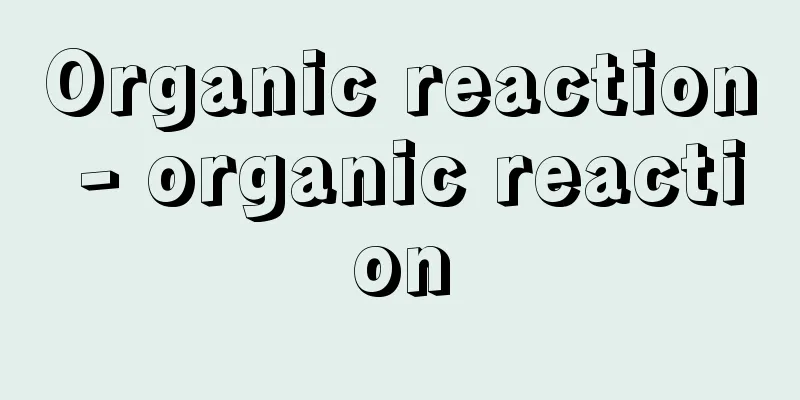Organic reaction - organic reaction

|
A chemical change in which an organic compound itself changes into another compound, or an organic compound interacts with another compound to produce yet another compound. It is also called an organic reaction. It corresponds to an inorganic chemical reaction, but the difference is that organic compounds are composed of covalent bonds, so it takes a lot of energy to break the covalent bonds and cause a chemical change. Therefore, organic chemical reactions are generally slower than inorganic chemical reactions, and the reaction product is often not limited to one type but a complex mixture. Organic chemical reactions are classified based on the type of covalent bond cleavage that occurs during the reaction: homolysis (also called radical bond cleavage), in which one covalent bond is cleaved to give two free radicals, and heterolysis (also called heterolytic bond cleavage), in which one covalent bond is cleaved to give a cation and an anion ( ). Reactions caused by the former are called radical reactions, and reactions caused by the latter are called ionic reactions. Organic chemical reactions can be further classified into unimolecular and bimolecular reactions based on the number of reactant molecules involved in the reaction. A―→C+D+……(unimolecular reaction) Reactions that produce polymers, such as polymerization and condensation, are basically bimolecular reactions. Termolecular reactions are also known to occur occasionally, but the probability of three molecules colliding and reacting at the same time is small, and in most cases, a trimolecular reaction is a reaction that consists of a series of two or more elementary reactions. [Mr. Hirota November 18, 2016] "The Simplest Organic Chemical Reactions - Transition States of Proton Transfer" edited by Ohno Junkichi (1997, Maruzen)" ▽ "Organic Chemical Reactions and Solvents" by Okuyama Itaru (1998, Maruzen)" ▽ "Iwanami Lectures: Introduction to Modern Chemistry 8, Reactions of Organic Compounds" by Sakurai Hideki (2002, Iwanami Shoten)" ▽ "The Mechanism of Organic Reactions" by Kato Akiyoshi (2004, Sankyo Publishing)" ▽ "The Mechanism of Organic Reactions as Seen through the Movement of Electrons" by Okuyama Itaru and Sugimura Takashi (2005, Tokyo Kagaku Dojin)" ▽ "Organic Chemical Reactions" by Matsumoto Masakatsu, Yamada Shinji, and Yokozawa Tsutomu (2005, Asakura Shoten)" [References] | | | | | | | |©Shogakukan "> Examples of chemical bond cleavage in organic compounds (Figure A... ©Shogakukan "> Example of organic chemical reaction (Figure B) Source: Shogakukan Encyclopedia Nipponica About Encyclopedia Nipponica Information | Legend |
|
有機化合物自身が他の化合物に変化したり、有機化合物が他の化合物と相互作用をおこしたりして、さらに別の化合物を生ずる化学的変化。有機反応ともいう。無機化学反応に対応する語であるが、有機化合物は共有結合から構成されているので、共有結合を切断して化学変化をおこさせるのに大きなエネルギーを要するという相違点がある。したがって、有機化学反応は、概して無機化学反応に比べて遅く、反応による生成物も1種類とは限らず複雑な混合物を与えることがしばしばおこる。 有機化学反応は、反応の際におこる共有結合の開裂の様式に基づいて分類され、1本の共有結合が切断されて二つの遊離基(フリーラジカル)を与えるホモリシス(均一結合開裂、ラジカル的結合開裂ともいう)と、1本の共有結合が切断して陽イオンと陰イオンを与えるヘテロリシス(不均一結合開裂、イオン的結合開裂ともいう)がある()。前者により引き起こされる反応をラジカル反応、後者により引き起こされる反応をイオン反応とよんでいる。 有機化学反応は、反応に関与する反応物の分子数からさらに一分子反応と二分子反応に分類できる。 A―→C+D+……(一分子反応) 重合や縮合などの高分子を生成する反応も、基本的には二分子反応である。三分子反応もまれに知られているが、三つの分子が一度に衝突して反応をおこす確率は小さく、多くの場合、三分子反応は一連の二つ以上の素反応で構成されている反応である。 [廣田 穰 2016年11月18日] 『大野惇吉編著『最も単純な有機化学反応――プロトン移動の遷移状態』(1997・丸善)』▽『奥山格著『有機化学反応と溶媒』(1998・丸善)』▽『櫻井英樹著『岩波講座 現代化学への入門8 有機化合物の反応』(2002・岩波書店)』▽『加藤明良著『有機反応のメカニズム』(2004・三共出版)』▽『奥山格・杉村高志著『電子の動きでみる有機反応のしくみ』(2005・東京化学同人)』▽『松本正勝・山田真二・横沢勉著『有機化学反応』(2005・朝倉書店)』 [参照項目] | | | | | | | |©Shogakukan"> 有機化合物中の化学結合の開裂の例〔図A… ©Shogakukan"> 有機化学反応の実例〔図B〕 出典 小学館 日本大百科全書(ニッポニカ)日本大百科全書(ニッポニカ)について 情報 | 凡例 |
<<: Organic analysis - organic analysis
Recommend
Exchange profits and losses - kawase sae kisason
When you have a net receivable or payable in a for...
Adam style
A style of interior decoration based on the delica...
Khamse tribe - Khamse tribe (English spelling)
The collective name for a confederation of five no...
Litigation Officer - Soshotantou
When a third party other than the person to whom t...
Ibara [city] - Ibara
A city in the southwest of Okayama Prefecture. It ...
Liquid Helium II - Equilibrium Helium
… Liquid 4He , or liquid helium-4, transitions to...
Kidara (English spelling)
...From this time on, the dynasty lost the wester...
Suntory [Stock] - Suntory
Founded in 1921 as Kotobukiya. With both the Sunto...
Milvus milvus (English spelling)Milvusmilvus
… [Kiyomitsu Sasaki]. … *Some of the terminology ...
Function - Kansuu (English) function
In the past, this was written as "function.&...
Cardano Solution - Cardano Solution
…The root of this new cubic equation is , where ω...
Tapestry - Tapestry
Also called Tsuzure Nishiki, this is a type of wo...
Motomasa Hikosaka
Year of death: January 8, 1634 (February 5, 1634) ...
Spherical cam - Spherical cam
…A cam similar to a cylindrical cam is a conical ...
Workplace discipline
Rules that workers must follow to maintain and imp...









